英汉拟声词对比翻译论文文献综述
论拟声词汉译英现象——基于英汉形意合及静动态
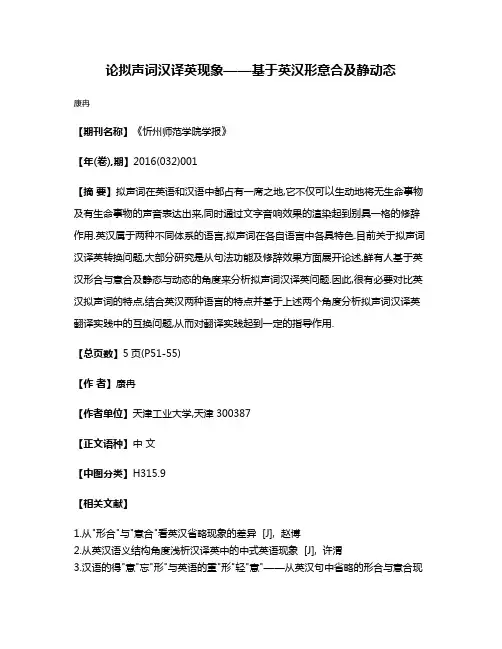
论拟声词汉译英现象——基于英汉形意合及静动态
康冉
【期刊名称】《忻州师范学院学报》
【年(卷),期】2016(032)001
【摘要】拟声词在英语和汉语中都占有一席之地,它不仅可以生动地将无生命事物及有生命事物的声音表达出来,同时通过文字音响效果的渲染起到别具一格的修辞作用.英汉属于两种不同体系的语言,拟声词在各自语言中各具特色.目前关于拟声词汉译英转换问题,大部分研究是从句法功能及修辞效果方面展开论述,鲜有人基于英汉形合与意合及静态与动态的角度来分析拟声词汉译英问题.因此,很有必要对比英汉拟声词的特点,结合英汉两种语言的特点并基于上述两个角度分析拟声词汉译英翻译实践中的互换问题,从而对翻译实践起到一定的指导作用.
【总页数】5页(P51-55)
【作者】康冉
【作者单位】天津工业大学,天津300387
【正文语种】中文
【中图分类】H315.9
【相关文献】
1.从"形合"与"意合"看英汉省略现象的差异 [J], 赵博
2.从英汉语义结构角度浅析汉译英中的中式英语现象 [J], 许渭
3.汉语的得"意"忘"形"与英语的重"形"轻"意"——从英汉句中省略的形合与意合现
象看英汉句法的最显著差异 [J], 舒立志
4.从形合和意合看英汉省略现象的差异及其翻译 [J], 崔薇
5.汉译英辅导(六)英汉差异和汉译英(之一) [J], 李运兴
因版权原因,仅展示原文概要,查看原文内容请购买。
大学英语专业毕业论文【浅谈英语拟声词的特点与翻译 】
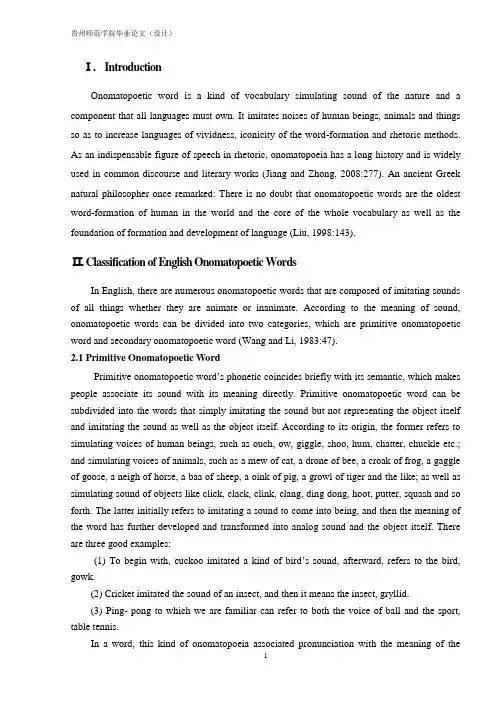
Ⅰ. IntroductionOnomatopoetic word is a kind of vocabulary simulating sound of the nature and a component that all languages must own. It imitates noises of human beings, animals and things so as to increase languages of vividness, iconicity of the word-formation and rhetoric methods. As an indispensable figure of speech in rhetoric, onomatopoeia has a long history and is widely used in common discourse and literary works (Jiang and Zhong, 2008:277). An ancient Greek natural philosopher once remarked: There is no doubt that onomatopoetic words are the oldest word-formation of human in the world and the core of the whole vocabulary as well as the foundation of formation and development of language (Liu, 1998:143).Ⅱ. Classification of English Onomatopoetic WordsIn English, there are numerous onomatopoetic words that are composed of imitating sounds of all things whether they are animate or inanimate. According to the meaning of sound, onomatopoetic words can be divided into two categories, which are primitive onomatopoetic word and secondary onomatopoetic word (Wang and Li, 1983:47).2.1 Primitive Onomatopoetic WordPrimitive onomatopoetic word’s phonetic coincides briefly with its semantic, which makes people associate its sound with its meaning directly. Primitive onomatopoetic word can be subdivided into the words that simply imitating the sound but not representing the object itself and imitating the sound as well as the object itself. According to its origin, the former refers to simulating voices of human beings, such as ouch, ow, giggle, shoo, hum, chatter, chuckle etc.; and simulating voices of animals, such as a mew of cat, a drone of bee, a croak of frog, a gaggle of goose, a neigh of horse, a baa of sheep, a oink of pig, a growl of tiger and the like; as well as simulating sound of objects like click, clack, clink, clang, ding dong, hoot, putter, squash and so forth. The latter initially refers to imitating a sound to come into being, and then the meaning of the word has further developed and transformed into analog sound and the object itself. There are three good examples:(1) To begin with, cuckoo imitated a kind of bird’s sound, afterward, refers to the bird, gowk.(2) Cricket imitated the sound of an insect, and then it means the insect, gryllid.(3) Ping- pong to which we are familiar can refer to both the voice of ball and the sport, table tennis.In a word, this kind of onomatopoeia associated pronunciation with the meaning of theword, and its sound can refer to the object itself.2.2 Secondary Onomatopoetic wordSecondary onomatopoetic word refers to an association between pronunciation and meaning, and its phonetic is a symbol of semantic to produce onomatopoetic words. This kind of onomatopoeia, unlike primitive onomatopoetic word, do not directly imitate sound of things to come into being, but by means of symbol to create a word. In English, this word is considered as having onomatopoetic function, because the pronunciation of the letter phoneme or phoneme combination in the word is particularly fitted for expressing a certain meaning, symbolic of a concept or a scene, thus arousing people to produce association. A case in point is that [m], a low nasal, is a symbol of low voices, such as: murmur, mutter, mumble, moan, hum and so on. So the Onomatopoetic words containing the phoneme of [m] just right accorded with the symbolic speech sound. And as words, ending with the three letters, -ump, may indicate a heavy impact like dump, thump, bump, lump, clump etc..III. The Characteristics and Functions of English Onomatopoetic WordsEnglish onomatopoetic word by imitating, drawing and rendering voice of all living things to stimulate people’s hearing and to cause people produce symbolic association can enhance the vividness and iconicity of language expression and gives people a kind of true voice and being personally on the scene (Li and Liu, 2009:164). There are four main characteristics in the onomatopoetic word.3.1 The FlexibilityFirst, it has flexibility. According to the general understanding, onomatopoetic words have taken shape by imitating sounds, but people ’s pronunciation organs can not accurately simulate all kinds of sounds, and different nationalities in the perception and simulation of sound is also not same. Taking the cry of a cock for instance, it is “喔喔喔”in Chinese, “cocorico” (Meng, 1994:561) in French, “Kikeriki” (Deng, 2003:716) in German, and “cock - a - doodle - doo” in English. The Onomatopoeia not only shows different forms in different languages, but also it is used very flexibly in the same language. Its flexibility performs: First of all, the same onomatopoeia can express different sounds. For example: in English, “roar” can refer to people’s laugh and cry of pain, the growls of lion and tiger, the wheeze and asthma of horse due to disease, the sound of storms and waves and the thrumming of the engines and so on. And “scream” means the sound of wind, a shrill whistle and the shriek of human and animals. Secondly, the same voice in English can be expressed by different onomatopoetic words.Looking at this example: These words, arf arf, bay, bow bow, growl and yip yip, can be used to express barking of dog. And the expression of the sound of clock or bell has more than 20 words like chime, chink, clang, clangor, clank, clink etc.. Of course, there are thousands of sounds in the world, and dictionaries can not include all voices whether any languages, English or Chinese, must create new words to express.3.2 The UniversalitySecondly, it has universality. The onomatopoeia is widely used in literatures, idioms, proverbs, daily conversations, news reports and other aspects. From A Comprehensive Dictionary Of English Idioms And Phrases compiled Xiamen university to A Dictionary of Current Idiomatic English edited by Qin Xiubai, we can see clearly that many idioms and phrases come from onomatopoetic words. From various literary works to news reports, we can also see extensive use of onomatopoeia. A writer once remarked: the use of onomatopoeia is everywhere. W e might as well have a look at the following examples:(1) There is no retreat but in Submission and Slavery ! Our chains are forged ! Their clanking may be heard on the plains of Boston !The two sentences come from a moving speech of the Virginia parliament made by the progressive of Patrick Henry during the American Revolution. Using of the onomatopoetic word, clanking, can give people great courage and power and boost inspiration of the speech as if the audience were there and saw slaves wearing heavy chains. The situation having been getting worse and worse, they must immediately take effective measures without any hesitation.(2) One of the most picturesque and impressive parts of the bazaar is the copper-smiths' market. As you approach it, a tinkling and banging and clashing begins to impinge on your ears.The three onomatopoetic words, tinkling, banging and clashing, have taken on a hustling and bustling scene in Eastern Bazaar, a bronze market. The three words would make readers feel a festive ambiance and scene.(3) My souls, how the wind did scream along! And every second or two there's come a glare that lit up the white caps for half a mile around, and you'd see the islands looking dusty through the rain and the trees thrashing around the wind, then comes a h-whack-bum! Bum bumble -umble-umbue-bum-um and the thunder would go rumbling and grumbling away, and quit -and the rip comes flash and another sockdolager (Twain, 2009:164).In the above paragraph, the writer, Mark T wain, used rhetoric of onomatopoeia and metaphor to vividly portray thunder. The word of crash shows a single sharp thunder, then “rumbling” and “grumbling”, a prolonged shriek of thunder, and then the “tumbling” and “rolling”, a long rumble and slow vanishing thunder.3.3 The IconicityThirdly, it has iconicity. The onomatopoetic word not only imitates sounds but also gives person a feeling of concrete, iconicity, vividness. Therefore, its widespread application has enlarged the English vocabulary. On the other hand, it increases charm of language. As the description of “wind”, we can see the following sentences:(4)The wind swirled and howled in the valley.(5)The wind whistle through the street.(6)A stirring blast of wind came and the leaves rustled.Wind” in the above sentences did neither simply blow nor a fixed voice. “Swirl”, “howl”, “stir” and “rustle”are the direct and indirect description of wind to make person hear the sound as if he was personally on the scene.Next, it has reverse. Some onomatopoeia in long term use has gradually lost its onomatopoeia significance and directly become the concept meaning of the word, even converted into verbs. For example:(7) The rain pattered all night.(8) A rock splashed down into the river.(9) Rainsford had not been entirely clear-headed when the chateau gates snapped shut behind him.In the above three sentences, the onomatopoetic words, patter, splash and snap, have completely transformed noun into verb, however, it is easy to see that they still have a very strong echoic element.3.4 The CreativityFinally, it has creativity. Onomatopoetic words mainly imitate sounds of the nature, but because human beings are the subject of social activities and can use ears and brains to feel and interpret as well as distinguish different sounds, even make a variety of sounds. Therefore, some new words do not mimic natural sounds, but human beings imagine sound to convey or express one's tender feeling as so to enhance the expression of language. Let’s take a look for the following sentences:(10) My day crackled ane were up in smoke.(11) His thoughts rattled through all the things and therefore he could not go to sleep though he lay in bed for six hours.In example (10), the “crackled” means a sharp and rapid slight voice, especially the sound of fuel or crackling in fire; and “my day” is compared to fuel, like disappearing smoke, which means I passed without any success those days. The metaphor was hit off and very successful. In example (11), thoughts wouldn't rattle even pass through things just in that the onomatopoetic word of rattle serves as thoughts of the predicate verb, then activates the abstract noun, thoughts, which not only can make sound, but also pass through.Two examples in the above succeeded in using onomatopoeia to flirt by the sound. The matter that cannot make voices was vividly portrayed. And making the sound, shape, meaning and feelings melts in a furnace and greatly enhances the expression of literal.IV. The Translation Skills of English Onomatopoetic WordsAccording to the characteristics and functions of onomatopoeia, we can easily make sense of the meaning of onomatopoetic word in various situations and also be more idiomatic translation of onomatopoeia in the sentence. T o sum up, Several methods like direct transliteration,converted translation and added translation are used to translate English onomatopoetic words.4.1 The Direct TransliterationPeople living in the same world have experienced the similar or same nature life. Therefore, simulating the sound of people, animals, or nature is same or similar in most cases. That is to say, for the same object making the sound, there is a basic correspondence and rough equivalence between Chinese and English. So when translating English onomatopoeia into Chinese, we can use the method of direct transliteration according to the sound of Chinese onomatopoeia (Liu, 2007:151-154). For example:(12)Pooh! What do you take me for? (呸! 你把我当成什么人了? )(13)The stream went gurgling on. (溪水潺潺地流。
英汉拟声词的对比研究

开封文化艺术职业学院学报Journal of Kaifeng Vocational College of Culture&Art 2020年10月20日Oct.202020第40卷第10期Vol.40No.10doi:10.3969/j.issn.2096-7853.2020.10.036英汉拟声词的对比研究赵佳琪(广西大学外国语学院,广西南宁530004)摘要:英语和汉语中的拟声词都是对自然声音和人声的模拟,因此,英汉拟声词具有许多相同点。
但是,由于语言结构和思维方式的不同,再加上文化传统的差异,英汉拟声词也具有许多不同之处。
加强英汉拟声词对比分析,有助于学习者加深对英汉语言系统的理解,增进对英汉两种文化的了解,并提高其使用两种语言的能力。
关键词:英语拟声词;汉语拟声词;语音;词形结构;句法功能中图分类号:H04文献标识码:A文章编号:2096-7853(2020)10-0085-02拟声词,同时又可以称为象声词(Onomatopoetic Words),是某种特定的语言中用来模拟自然或人为声音而形成的词项。
不同地区的人有不同的发音习惯,因此英汉拟声词存在异同⑴。
由此,本文主要从语音、词形结构、句法功能、审美功能四方面对英汉拟声词的异同进行对比分析。
—、语音对比(-)相同之处语义学理论认为,语言符号(Symbol)和所指对象(Referent)之间没有直接必要的联系,但拟声词是一个例外。
英语和汉语在听觉和声音模仿上有相似之处,因此,英语的部分拟声词和汉语的部分拟声词在语音形式上重合。
例如:牛叫声:moo------哗眸笑声:ha ha------哈哈狼叫声:howl------嗥爆炸、拍打的声音:bang------呼(二)不同之处拟声词是某个民族根据其语言固有的语言系统对客观世界的声音进行改造加工的结果,是某一特定语言和自然声音相结合的产物。
各种语言的语音结构、词汇形态各不相同,不同民族对同一声音的听觉感知和模拟习惯也不同,再加上民族文化传统的差异,不同语言中的拟声词在语音形式上就可能出现较大差别⑵9。
英汉词语对比研究综述
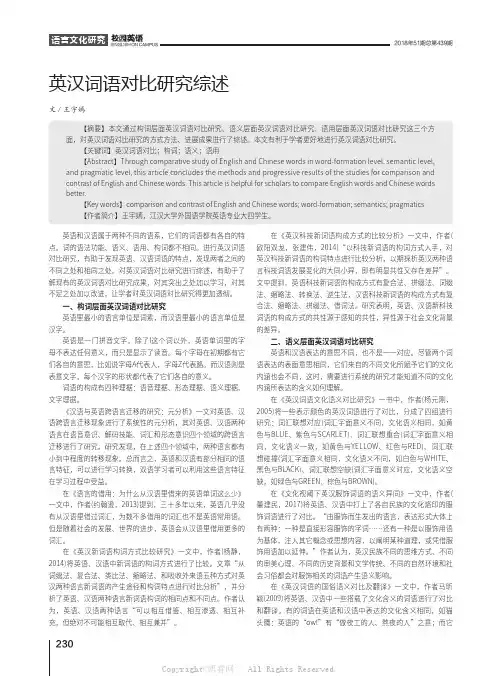
2302018年51期总第439期ENGLISH ON CAMPUS英汉词语对比研究综述文/王宇嫣【摘要】本文通过构词层面英汉词语对比研究、语义层面英汉词语对比研究、语用层面英汉词语对比研究这三个方面,对英汉词语对比研究的方式方法、进展成果进行了综述。
本文有利于学者更好地进行英汉词语对比研究。
【关键词】英汉词语对比;构词;语义;语用【Abstract】Through comparative study of English and Chinese words in word-formation level, semantic level,and pragmatic level, this article concludes the methods and progressive results of the studies for comparison and contrast of English and Chinese words. This article is helpful for scholars to compare English words and Chinese wordsbetter.【Key words】comparison and contrast of English and Chinese words; word-formation; semantics; pragmatics 【作者简介】王宇嫣,江汉大学外国语学院英语专业大四学生。
在《英汉科技新词语构成方式的比较分析》一文中,作者(欧阳双龙,张建伟,2014)“以科技新词语的构词方式入手,对英汉科技新词语的构词特点进行比较分析,以期探析英汉两种语言科技词语发展变化的大同小异,即有明显共性又存在差异”。
文中提到,英语科技新词语的构成方式有复合法、拼缀法、词缀法、缩略法、转换法、逆生法,汉语科技新词语的构成方式有复合法、缩略法、拼缀法、借词法。
英汉拟声词对比翻译研究
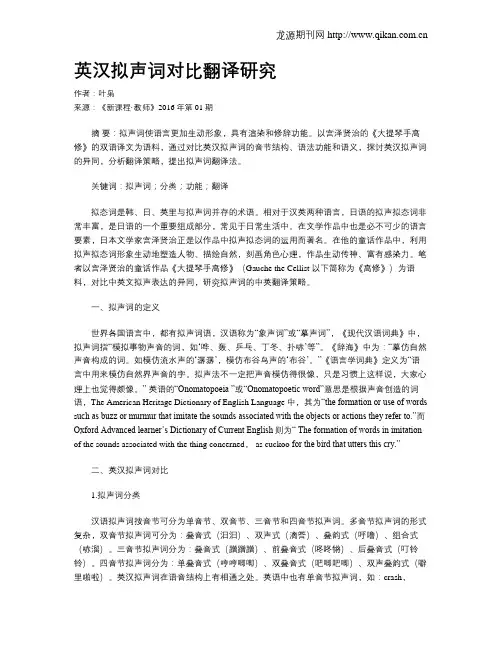
英汉拟声词对比翻译研究作者:叶枭来源:《新课程·教师》2016年第01期摘要:拟声词使语言更加生动形象,具有渲染和修辞功能。
以宫泽贤治的《大提琴手高修》的双语译文为语料,通过对比英汉拟声词的音节结构、语法功能和语义,探讨英汉拟声词的异同,分析翻译策略,提出拟声词翻译法。
关键词:拟声词;分类;功能;翻译拟态词是韩、日、英里与拟声词并存的术语。
相对于汉英两种语言,日语的拟声拟态词非常丰富,是日语的一个重要组成部分,常见于日常生活中。
在文学作品中也是必不可少的语言要素,日本文学家宫泽贤治正是以作品中拟声拟态词的运用而著名。
在他的童话作品中,利用拟声拟态词形象生动地塑造人物、描绘自然,刻画角色心理,作品生动传神、富有感染力。
笔者以宫泽贤治的童话作品《大提琴手高修》(Gauche the Cellist 以下简称为《高修》)为语料,对比中英文拟声表达的异同,研究拟声词的中英翻译策略。
一、拟声词的定义世界各国语言中,都有拟声词语,汉语称为“象声词”或“摹声词”,《现代汉语词典》中,拟声词指“模拟事物声音的词,如‘哗、轰、乒乓、丁冬、扑哧’等”。
《辞海》中为:“摹仿自然声音构成的词。
如模仿流水声的‘潺潺’,模仿布谷鸟声的‘布谷’。
”《语言学词典》定义为“语言中用来模仿自然界声音的字。
拟声法不一定把声音模仿得很像,只是习惯上这样说,大家心理上也觉得颇像。
” 英语的“Onomatopoeia ”或“Onomatopoetic word”意思是根据声音创造的词语,The American Heritage Dictionary of English Language中,其为“the formation or use of words s uch as buzz or murmur that imitate the sounds associated with the objects or actions they refer to.”而Oxford Advanced learner’s Dictionary of Current English则为“ The formation of words in imitation of the sounds associated with the thing concerned, as cuckoo for the bird that utters this cry.”二、英汉拟声词对比1.拟声词分类汉语拟声词按音节可分为单音节、双音节、三音节和四音节拟声词。
浅谈英汉拟声词的异同
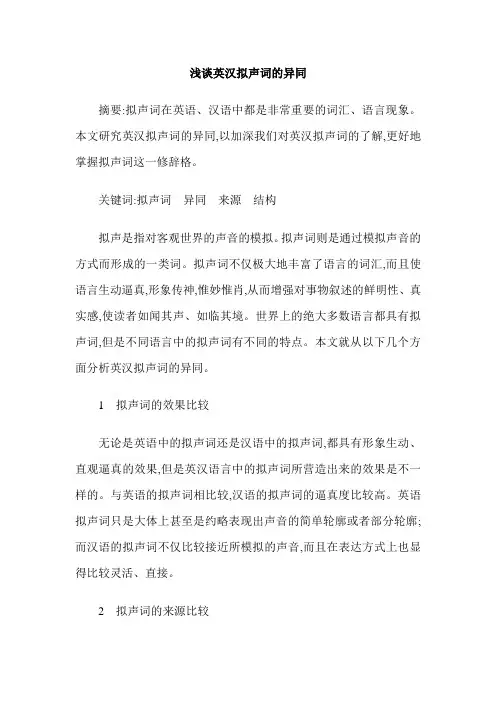
浅谈英汉拟声词的异同摘要:拟声词在英语、汉语中都是非常重要的词汇、语言现象。
本文研究英汉拟声词的异同,以加深我们对英汉拟声词的了解,更好地掌握拟声词这一修辞格。
关键词:拟声词异同来源结构拟声是指对客观世界的声音的模拟。
拟声词则是通过模拟声音的方式而形成的一类词。
拟声词不仅极大地丰富了语言的词汇,而且使语言生动逼真,形象传神,惟妙惟肖,从而增强对事物叙述的鲜明性、真实感,使读者如闻其声、如临其境。
世界上的绝大多数语言都具有拟声词,但是不同语言中的拟声词有不同的特点。
本文就从以下几个方面分析英汉拟声词的异同。
1 拟声词的效果比较无论是英语中的拟声词还是汉语中的拟声词,都具有形象生动、直观逼真的效果,但是英汉语言中的拟声词所营造出来的效果是不一样的。
与英语的拟声词相比较,汉语的拟声词的逼真度比较高。
英语拟声词只是大体上甚至是约略表现出声音的简单轮廓或者部分轮廓;而汉语的拟声词不仅比较接近所模拟的声音,而且在表达方式上也显得比较灵活、直接。
2 拟声词的来源比较英汉拟声词的来源是完全相同的,都来源于以下四个方面。
2.1 人的声音人的声音是英汉拟声词的共同来源,包括人的笑声、哭声、说话声以及人的一些动作发出的声音。
例如,汉语中的拟声词“嘤嘤”“嗷嗷”“哇哇”“格格”“呼哧”模拟的分别是低泣声、哀号声、大哭声、笑声、喘气声等。
同样,英语中也有很多模拟人的声音的拟声词。
例如,giggle 模拟咯咯的笑声, snigger模拟窃笑声,mumble模拟含糊不清的咕哝声,murmur模拟耳语声,groan模拟痛苦的呻吟声,boom模拟雷鸣般的说话声,等。
2.2 动物的声音拟声词不仅包括了模拟人类自身的声音,也包括了模拟动物的声音。
世界上的动物千万种,包括了各种飞禽走兽,因此来源于动物声音的拟声词也比较多。
比如,coo(咕咕)模仿鸽子的叫声,mew,meow(喵)模拟猫叫声,“汪汪”(bark)模拟狗叫声,“咩咩”(bleat)模拟羊叫声,嗡嗡”(buzz)模拟蜜蜂的声音。
英汉对比研究综述和构想
英汉对比研究综述和构想英汉对比研究是一种探究英语和汉语之间异同的研究方法,对于语言学、翻译学、跨文化交际等领域具有重要意义。
本文旨在综述英汉对比研究领域的发展历程、研究现状、方法、成果和不足,并提出未来研究的构想。
通过了解英汉语言的异同,我们可以更好地理解两种语言及其文化背景,为翻译、国际交流、语言教育等方面提供理论支持和实践指导。
随着全球化的推进,英语作为国际交流的主要语言之一,越来越受到人们的。
与此同时,汉语作为世界上使用人数最多的语言之一,也越来越受到国际社会的重视。
英汉对比研究通过对比分析英语和汉语的异同,为翻译学、语言学、跨文化交际等领域提供了重要的理论支撑和实践指导。
本文将介绍英汉对比研究的主要发展历程、研究现状、方法、成果和不足,并提出未来研究的构想。
英汉对比研究的起源和背景英汉对比研究起源于20世纪初,当时主要目的是为了促进英语和汉语之间的翻译。
随着时间的推移,英汉对比研究逐渐发展成为一门独立的学科,涉及到语言学、翻译学、跨文化交际等多个领域。
英汉对比研究的方法主要包括平行语料库研究、对比分析、翻译研究等。
其中,平行语料库研究是最常用的方法之一,它通过对大量英汉平行语料库进行分析,探究两种语言的异同。
对比分析则通过对英语和汉语的语言结构、词汇、语法等方面的对比,揭示两种语言的本质特征。
翻译研究则从翻译实践和理论的角度出发,对比分析英语和汉语的翻译过程和结果。
英汉对比研究在多个领域具有广泛的应用价值。
在语言学领域,英汉对比研究可以帮助我们更好地了解英语和汉语的语言特征和演化过程。
在翻译学领域,英汉对比研究可以为翻译理论和实践提供重要的支持和指导,提高翻译的准确性和效率。
在跨文化交际领域,英汉对比研究可以帮助我们更好地了解两种文化及其语言表达方式的异同,促进跨文化交流和理解。
英汉对比研究仍面临许多挑战,例如语言差异巨大、语料库资源有限等。
为了解决这些挑战,研究者们需要加大力度搜集整理英汉平行语料库资源,同时采用先进的统计方法和计算机技术进行数据分析。
汉英拟声词对比与翻译
汉英拟声词对比与翻译翁敏雅【期刊名称】《宁波广播电视大学学报》【年(卷),期】2014(000)004【摘要】Both Chinese and English have a great number of onomatopoeic words. This paper conducts a contrast study on Chinese and English onomatopoeic words based on three respects: namely, phonetic structure, equivalence of their expressions (phonetics and semantic meanings) and syntactical function. Furthermore, the author has a further study about translation on Chinese-English onomatopoeic words on the basis of their similarities and differences. The translation methods can be divided into literal translation, conversion and free translation.%汉英语中存在着大量的拟声词。
本文就汉英拟声词的语音结构、表达式的对应情况以及句法功能进行对比研究,发现了它们的异同点。
基于这些异同点,作者进一步探讨了汉英拟声词的翻译策略,即直译、转换和意译。
【总页数】5页(P40-44)【作者】翁敏雅【作者单位】宁波大红鹰学院,浙江宁波 315175【正文语种】中文【中图分类】H085.3【相关文献】1.汉英拟声词对比研究 [J], 裴紫伊;2.从汉英拟声词对比看汉语拟声词的民族特点 [J], 贾林华3.汉英拟声词对比与对外汉语教学 [J], 彭洁;刘琪4.汉英拟声词对比与对外汉语教学 [J], 彭洁;刘琪5.汉英对比视角下翻译策略研究——以《忆大山》汉英翻译为例 [J], 孙亚秋因版权原因,仅展示原文概要,查看原文内容请购买。
1英汉拟声词比较
健身者健身效果
强身
良好反应(人)
不良反应(人)
健体 减肥 去病 心情好皮肤好 年轻 头晕 压气 扭伤 拉伤
100 90 84 100 60 80 5 20 25 20
各个部位的力量, 使运动员达到最佳的身体状态。
参考文献: [1]《上海体院学报》 2000 年 8 月陈先良等《爆发力的训练方法及 其应注意的问题》 [2]《体育科研》季刊 1998 年第 4 期,王丽娣的《篮球运动员的力 量训练》 [3]《武汉体院学报》 2000 年第 1 期,王加强的《篮球运动员弹跳 力的训练及其生理依据》 [4]《篮球》 人民教育出版社出版 1990 年 6 月第 1 版
-106-
使文章更加丰富多彩,更加生动,具有说服力。此外,英汉拟声词共性 与个性的探讨,使得我们能够更好的处理翻译中的拟声词问题,从而提 高翻译质量。总而言之,拟声词的学习是语言学习中无法避免又必须面 对的问题。因此,笔者希望本文能够在读者处理语言学习中的拟声词问 题时贡献微薄力量。
参考文献: [1]何善芬。《英汉语言对比研究》。上海:上海外语教育出版社,2002。 [2] 庞林林。《英、汉语拟声词异同浅探》。 解放军外语学院学报。 1995 (4)。 [3] 王月华 隋慧。《英汉拟声词的对比》 河北职业技术学院学报。 2004 (4) 3。 [4] 徐明。《汉语、英语拟声词异同探微》 延边大学学报(社会科 学版)。2005 (38) 2。
专题与学科
英汉拟声词比较
杜丽华( 石家庄铁道学院外语系 河北石家庄 050043)
关于英汉翻译论文范文
关于英汉翻译论文范文浅谈英汉翻译、英汉语言特点对比【摘要】在当今日趋全球化的时代里,翻译在跨文化、跨民族之间的交流和合作中功不可没,它既是语言之间的相互转换,同时也是不同文化间的交流。
事实上,翻译已经成为了一种普遍性的活动,当今的人们直接或者间接都有意或无意地从事着翻译活动。
【关键词】翻译语系形合意合英语和汉语分属于不同语系,英语属于印欧语系Indo-European language Family,是拼音语言,而汉语属于汉藏语系Chinese-Tibetan language family,是表意的语言ideography,所分属的语系不同也就导致了英汉两种语言的差别。
对于广大应试四、六级的考生来说,如果平时学习中了解英汉语言特点,在翻译应试中能满足翻译标准――“信、达、雅”即忠实准确、通顺流畅和贴切原文,这对于想要取得较高翻译分数会有很大帮助,下面本文就将对英汉语言的特点从下几个方面作对比。
一、英语的形合和汉语的意合相对于汉语来说,英语是一种更加注重形式化的语言,主要体现在运用词汇来联系各个分句,如我们熟知的“and”用来表示并列连接;“if”用来表示假设条件关系;“because”用来表示因果关系,虽然说汉语句式也有一定数量的连接词连接,但是使用频率较之英语小得多。
在汉语中,我们通常不用或者少用连接词来表达意思,英汉两种语言的这种区别就是我们所说的形合――强调结构的完整性和形态的严谨性,结构严密紧凑,主次分明;意合――强调内容和表意的完整性,靠语意的逻辑将句子串起。
为了更加清楚明了,我们试举几个例句:1跑得了和尚,但是跑不了庙。
The monks may run away,but the temple cannot run away with him.2Althoughhe has aged physically, he remains young at heart.尽管他人老但是心不老。
- 1、下载文档前请自行甄别文档内容的完整性,平台不提供额外的编辑、内容补充、找答案等附加服务。
- 2、"仅部分预览"的文档,不可在线预览部分如存在完整性等问题,可反馈申请退款(可完整预览的文档不适用该条件!)。
- 3、如文档侵犯您的权益,请联系客服反馈,我们会尽快为您处理(人工客服工作时间:9:00-18:30)。
Onomatopoeia is an important way of word-formation and a kind of rhetorical device. It uses the sound to reflect the sense, that is, the pronunciation of one word is the echo to the sense- the naming of a thing or action by a vocal imitation of the sound associated with it (as buzz, hiss) or the use of words whose sound suggests the sense. The creations of onomatopoeias are very simple and original. People just imitate the sounds of the animals or other things that can produce sounds. There are great numbers of onomatopoeias in each language. Onomatopoeias are important figures of speech that enrich the language. There exist the differences and similarities between English and Chinese onomatopoeias from aspects of phonetics, part of speech, syntactic function and semantics. The similarities mainly exist in partial similar phonetics, the diversities of part of speech and syntactic function, the transference of semantics and its usage. The differences mainly arise in phonetics, part of speech, semantics and syntactic function. So it’s necessary to pay attention to the same aspects and difference of onomatopoeias between Chinese and English and to make an in-depth research. At the same time, in the translation of onomatopoeia between Chinese and English, people have figured out many effective ways, however, they are very scattered. Many researches are made to explore the translation skills of onomatopoeia, which includes the transliteration and complement method. Hu Zhuanglin, in his famous book Linguistics, points out that words that sounds like the sounds they describe are called onomatopoeias, such as 叮咚,轰隆 in Chinese. But in English, totally different words are used to describe the sound. For example, the dog barks bowwow in English but wang wang wang in Chinese. But there are some misunderstandings about the onomatopoeic effect. As a matter of fact, arbitrary and onomatopoeic effect may work at the same time. For example, Widdowson cites a line from Keats’ Ode to a nightingale to illustrate: the murmurrous haunt of flies on summer eves. If you read it about, you may feel the connection between the sounds and the meaning. But the effect does not really result from the whispering sounds themselves, for you will have to know the meaning of the words murmurous, summer, before setting up such a connection. To test this, just think of using the similar sounding word murderous to substitute murmurous, and no connection whatsoever will be established between the sounds and the little noises of the flying flies. “It is only when you know the meaning that you infer that the form is appropriate.” This also applies to many cases of the so-called onomatopoeic words. Bloomfieild defined some onomatopoeia as secondary onomatopoeia, which refers to certain sounds and sound- sequences are associated with certain senses in an expressive relationship. In this form, the sounds evoke, not an acoustic experience, but a movement (dither, dodder, quiver, slink, slither, slouch, squirm, wriggle), or some physical or moral quality, usually unfavorable (gloom, grumpy, mawkish, slimy, sloppy, sloth, wry). Some of these onomatopoeic terms have certain elements in common; in Bloomfield’s words, there is “a system of initial and final root-forming morphemes, of vague signification”, with which the “intense, symbolic connotation” of such termsis associated. For example, the sounds /sn/ may express three types of experiences: “breath-noise” (sniff, snuff, snore, and snort), “quick separation or movement” (snip, snap, snatch), and “creeping” (snake, snail, sneak, snoop). Final group have similar functions: -are suggests “ big light or noise” as in blare, flare, glare, stare;-ump suggests “protuberance” as in bump, chump, clump, dump, hump, lump, mump” and “heavy fall” as in dump, crump, flump, plump, slump, thump. Another interesting feature of onomatopoeic patterns is that they often work by vowel alternation; by substituting one vowel for another one can express different noises. Guo Zhuzhang, in his A Practical Course in Translation between English and Chinese, points out that there are a lot of skills to translate onomatopoeia, which includes three ways. (a). Literal translation. If there are onomatopoeias in the original article, we should use onomatopoeias in the target languages when we translate them. For examples: 1)Two heavy guns went off in the woods-Brump! Brump! 两门重炮在森林里开始发射了-轰隆!轰隆! (2)Whee-ee-ee! Whee-ee-ee! The police whistles shrilled suddenly“鸣-!鸣-!” 警笛突然响了。3)Thump! A table was overturned! “ 哗啦!”桌子被推翻了。(b). Translating the onomatopoeias of English to Chinese:”…的叫 or …的声”. For examples: 1) we heard the machines whirr. 我们听到了机器声。 2).The cock in th yard crowed its first round. 院子里的雄鸡已经叫头遍了。3).He felt as if he must shout and sing, he seemed to hear about him the rustle of unceasing and innumerable wings. 他感到简直要大喊大唱,耳际仿佛传来无数翅膀的拍击声。 (c) Adding onomatopoeias into the target language in order to make it vivid. According to it, when we translate the English into Chinese, even there are no onomatopoeias; we can still add some proper onomatopoeia in the target language, which can make it more infectively. For examples: 1) The stone fell on his head.石头“吧嗒”落在他的头上。 2)The child fell into the water.小孩“扑通”落到水里去了。3).Then a dog began to howl somewhere in a farm house far down the road--a long, agonized wailing, as if from fear. 接着,路尽头一所农舍附近响起狗的汪汪声,那是一声长长的哀鸣,似乎是因恐惧而发出的惊恐之声。4)There is some sentences from Thoreau’s Walden : I seldom opened my door in a winter evening without hearing it; Hoo hoo
